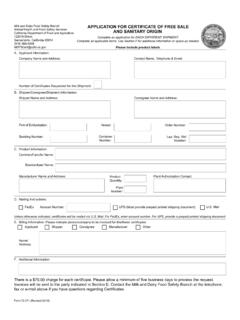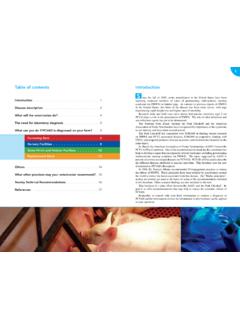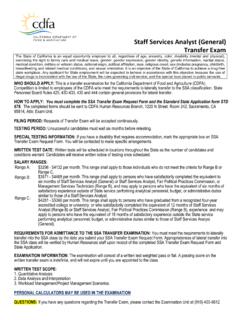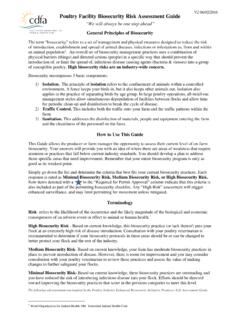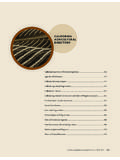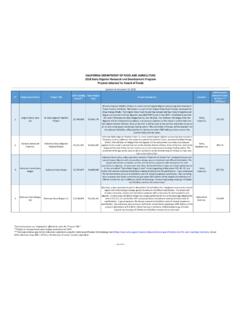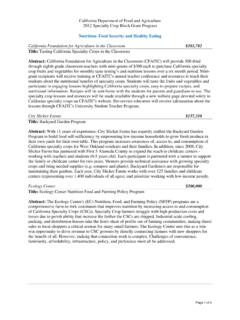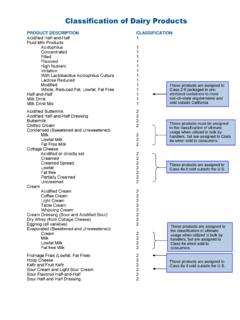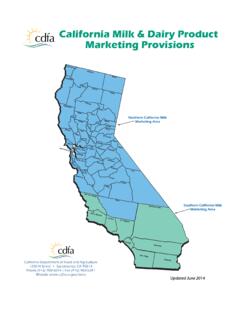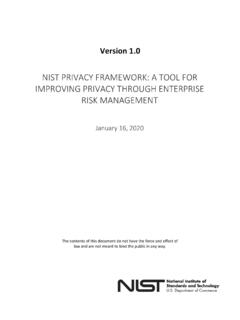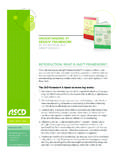Transcription of Agricultural Land Loss and Conservation
1 19 Agricultural land loss & Conservation Of california s approximately 100 million acres of land , 43 million acres are used for agriculture. Of this, 16 million acres are grazing land and 27 million acres are cropland. Only about 9 million acres of irrigated land (see illustration), or one-third of the state s cropland, are considered to be prime, unique or of statewide importance. About million acres of land in california s Agricultural counties are now urbanized. (Another 2 million acres are in areas that are so urbanized that there is no more agriculture.) Development is now consuming an average of about 40,000 acres of Agricultural land per year. One-sixth of the land urbanized since the Gold Rush, 538,000 acres, has been developed since 1990.
2 Of this, 28 percent or 152,000 acres of land , were prime, unique or statewide important farmland. In the San Joaquin Valley, which accounts for over half of california s total Agricultural output, more than 60 percent of all land developed was prime, unique or of statewide importance. Less than 40 percent of all land in this region falls into these categories. The disproportionate consumption of the best farmland is occurring primarily because most california cities were located in areas with good soils and abundant water, and most development is now occurring on the immediate urban fringe. An exception to typical urban-edge development is the proliferation of very-large lot (5-40 acre) rural residences that have the appearance of farms or ranches, but are not, and are unlikely ever to be, used for commercial agriculture.
3 Statewide data do not exist on these ranchettes, but in the San Joaquin Valley, the Farmland Mapping & Monitoring Program has documented 143,000 acres devoted to this use, accounting for 20 percent of all developed land in that region while housing a much smaller fraction of the population. The underlying causes of farmland loss in california are rapid population growth and the inefficient use of land . Since 1990, urban development has consumed an acre of land for every people statewide. In the San Joaquin Valley, the rate was an acre for every 8 people. In contrast, recent development in Sacramento County, an acknowledged leader in efficient growth, accommodated 20 people per acre. 20 Additional land has been removed from agriculture for environmental purposes, mainly the creation or enlargement of wildlife refuges and withdrawals due to water shortage.
4 Between 2004 and 2006 alone, irrigated farmland declined by more than 200,000 acres statewide due to these and similar causes. Unless issues related to the impact of irrigation on the Delta are resolved, there is a significant risk much more farmland will be permanently lost to agriculture or, at least, to irrigated crop production. If current development trends continue, million acres of california Agricultural land , including 670,000 acres of prime, unique and statewide important farmland, will be developed by 2050. For irrigated cropland alone, this would entail an annual loss of an estimated $2 billion in Agricultural production in current farm gate dollars. Only five counties in california now produce more than that.
5 Though california agriculture has thus far prospered despite the loss of farmland, it remains to be seen whether this will continue. Between 1949 and 1989, Agricultural productivity growth in california averaged percent per year, while from 1990 to 2002 it slowed to percent. Historic increases in Agricultural productivity have been sustained largely by expanding water supplies, the increasing use of fossil energy and more sophisticated technology. All of these are now under mounting pressure because of scarcity, cost and public opposition, , agrichemicals and GMOs, not to mention the uncertain impact of climate change. Have we reached a tipping point? Regardless, farmland lost is gone forever, and the continuing loss of the state s best land narrows the options and reduces the resilience of california agriculture.
6 Some california farmland will continue to be lost to urban and other uses in the future. But more effective farmland retention and urban development policies could significantly reduce the loss . In the San Joaquin Valley, a recent study done for a regional planning process called the Blueprint, found that increasing urban densities to 10 dwellings per acre comparable to those in the more suburban areas of the state could reduce farmland loss by 53 percent or 174,000 acres by 2050. california has a complicated fabric of policies that address the retention of farmland for agriculture. The closest thing the state has to an official policy is AB 857 (2003), which established farmland retention as one of three state planning priorities.
7 (Another priority, efficient urban development, would also conserve farmland.) This law requires state agencies to apply the policy and calls for an annual report by the Governor on their progress, but neither has occurred to date. The california Environmental Quality Act (CEQA) includes farmland loss as a significant impact that must be avoided or mitigated, and some mitigation has occurred, resulting in the preservation of several thousand acres of land under Conservation easement. The california Farmland Conservancy Program (CFCP), administered by the Department of Conservation , has invested $62 million in the acquisition of Conservation easements on 41,000 acres, leveraging its funds with $51 million in local, federal and private contributions.
8 State funds have come from bond acts and Williamson Act cancellation fees. Since the inception of the CFCP, the state has spent about 17 cents per capita per year on Agricultural Conservation easements, well below national leaders like Maryland ($4 per capita per year to protect 336,000 acres) and Pennsylvania ($ to protect 408,000). Private land trusts have also acquired 21conservation easements over at least 200,000 acres of california Agricultural land , most of it rangeland. The Williamson Act (1965) is perhaps the state s best-known farmland retention policy. It was intended to take development pressure off farmland by reducing property taxes in exchange for an annually-renewing 10-year commitment not to develop the land .
9 About million acres of land are now enrolled in Williamson at an annual cost of just under $40 million in state subvention payments to local governments (plus an undetermined amount of foregone local property tax revenue). The efficacy of the law as a deterrent to farmland conversion is called into question by the pattern of enrollment, which tends to be very spotty around cities where land is most likely to be developed. Recently-enacted state climate legislation (AB 32 and SB 375) may also have a salutary effect on farmland conversion by encouraging more compact, efficient development that not only requires less auto use and, hence, produced fewer greenhouse gas emissions, but also consumes less land per capita.
10 A considerable number of california counties and cities have farmland retention policies, often as part of their general plans. Most call for avoiding the best land and developing land more efficiently. As farmland conversion data show, however, these well-intentioned policies have been largely ineffective. Local governments seldom appear to apply them to actual development proposals or to measure their performance against their stated policies. On the other hand, a few local governments in california have very comprehensive and effective farmland Conservation programs that are considered national models. Most notable among them are Marin, Sonoma, Napa, Ventura and Yolo Counties. In contrast, leading Agricultural counties such as Fresno, Tulare and Monterey have been struggling to adopt and implement effective farmland Conservation policies.
